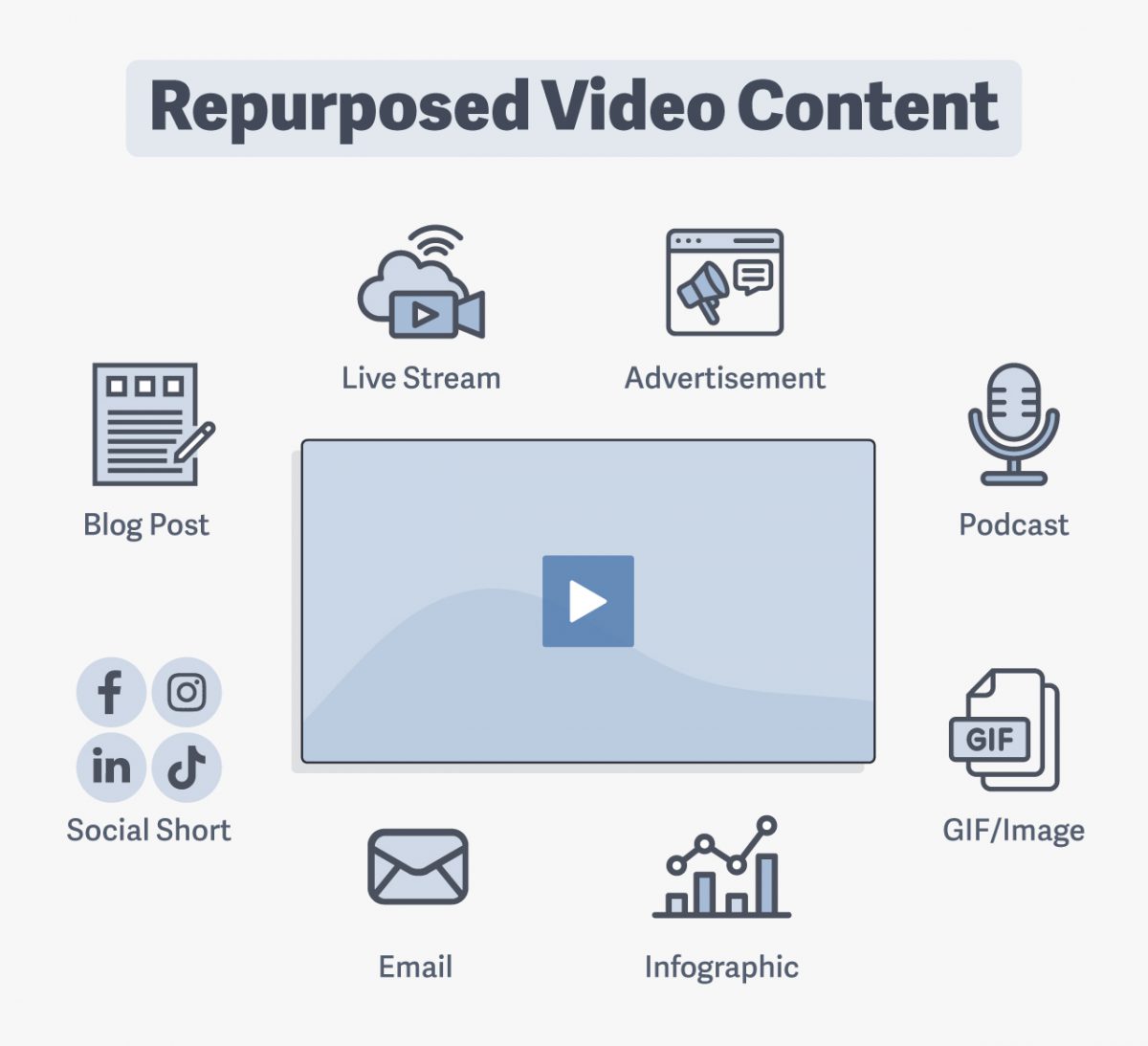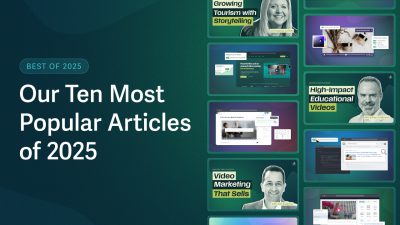Expand the reach of every video you make without creating new content. Video content repurposing is simply repackaging your valuable video content into multiple formats.
This practice encourages brand growth by diversifying how customers connect with your content across marketing channels.
Video content repurposing also makes it easier to maximize your investment and find new audiences who connect with your offerings.
Learn how to leverage the full value of your video content with these examples. Here are ten powerful ideas to drive ongoing growth with video content repurposing.
What Is Content Repurposing?

Content repurposing is reformatting original content into different mediums (video, blog post, infographic, etc.) for various purposes or channels. It allows you to extend the life of video content and expand its potential reach with content distribution.
For example, we shared a video on 2D animation for beginners in our Video Library. We also created a companion blog post optimized for search engines. We promoted the video with a social media short and clickable thumbnail in an email to our subscribers.
The Benefits of Repurposing Video Content
Video content repurposing provides exponential business benefits. Far beyond just saving marketers time, you can use content repurposing to:
- Leverage Your Investment: Reuse high-converting videos for additional growth.
- Reach Different Audiences: Improve reach by engaging audiences where they are.
- Increase Accessibility: Share multiple formats to suit different preferences.
- Automate Growth: Extend the life of your content and increase lead generation.
10 Powerful Ways To Repurpose Video Content
1. Advertisement
Turn longer videos into short advertisements for distribution across your ad network. This method allows you to share a consistent message and reinforce your branding with multiple audiences.
Identify interesting soundbites, calls to action, and main selling points from your video. Then, use a video editing program to assemble these segments into an ad.
Since video ad lengths and optimization standards vary by platform, determine where you will share the video ad before you begin. Often, what works best varies by platform.
2. Live Stream
Host a live stream to share even more in-depth information about the topic you covered in your video. Live streams provide an exclusive, close-knit experience, allowing viewers to ask questions and get real-time answers. For this reason, live streams are effective for building brand trust, which can expedite your potential customer’s path to purchase.
Live streams require a decent time investment; therefore, choose topics based on blog posts and videos that have led to new leads and successful purchases or subscriptions.
3. Blog Post
Extend the life of your content by creating blog posts optimized for search from your videos. This method of repurposing video content is especially useful for expert interviews, current trends, and educational content.
However, any video can become a blog post when you find the angle that hooks your audience. The post might offer behind-the-scenes insights or reflections on what could have gone better during the shoot—your imagination is the only limit!
When possible, plan ahead so you can capture behind-the-scenes images or videos. It’s also helpful to keep notes during the process or save documents used to collaborate with your team.
For example, we wrote about producing an explainer video for less than $4k. We shared our experience to help others do the same. By providing hands-on guidance, we became a trusted source and connected with prospective customers.
4. Email to Subscribers
Did you know that email marketing often outperforms most other channels? After all, opt-in subscribers asked to hear from you, which may be why email has one of the highest investment returns.
Promote your video’s value with an email to your subscribers. Guide subscribers to your video content or repurpose your video into newsletter form.
When directing traffic to your video, use SproutVideo to easily embed a clickable thumbnail within the email to encourage click-throughs.
SproutVideo accounts also integrate with the email marketing platform of your choice, allowing you to automatically track the email addresses of anyone who clicks on this embed and review them in your engagement metrics.
5. Shareable Infographic
Convert one major takeaway from your video into an infographic. Infographics are especially popular on Pinterest but can be shared across many social platforms and included within your blog post, which opens up the possibility of ranking the image with search engines as well.
Start by planning the key concepts and data points you want to use from your video. You can use stills to visualize your idea or borrow shots directly from the video. For instance, videos with motion graphics have graphic files that you can use for your infographic.
To create an infographic, you can use many online tools, including Canva, Piktochart, and Venngage. Photoshop and InDesign are also great choices.
6. Short Social Media Video
Social media shorts allow you to edit the sound bites, hooks, and key compelling information from your longer videos into highly digestible shorts. Social shorts are most effective for generating awareness with a broader audience and reaching new leads.
To start, select the most shareable moments. Then, optimize your short video for the social media platform where your core buying audience is likely to be found.
For example, we repurposed our video on Getting Started with Live Streaming into a social media short that we shared across our social media channels.
Even if you only create private video content that is either monetized or reserved for your customers, consider selecting high-value clips to share publicly. This practice will provide insight into your offerings and entice viewers to want to learn more.
7. Downloadable Resource
When a video contains unique information or actionable advice, consider creating a downloadable resource to give viewers additional, free value.
Determine what information from your video would be most helpful for viewers. Consider how you might compile this information into a format your viewers will use regularly—checklists, templates, reference sheets, and step-by-step how-to guides.
Apply your branding style to the downloadable content so that users think of your company while appreciating the free value provided through this resource.
For example, the companion blog for our video on The Basics of Video Editing in Premiere Pro includes a downloadable Keyboard Shortcuts cheat sheet. We turned this resource into a lead magnet, allowing us to gain new email subscribers in exchange for the resource.
8. GIFs and Images for Social Media
Capture GIFs and still images from your videos for use in promotional materials, social media posts, or supplemental images within a blog post.
Using the SproutVideo platform, you can quickly grab any high-resolution frame from your video. To do this, select a custom thumbnail (poster frame) for the video. Choose Download at the top of the video settings page and save the Poster Frame.
9. Podcast Episode
Podcasts can be distributed across many platforms, giving you an opportunity to reach new people while providing your current audience with an alternative way to engage.
In the U.S. alone, 47% of adults listened to a podcast in the last month. Many popular podcast formats exist, so determine which format best aligns with your content.
When repurposing video content into a podcast, it can be challenging to convey the information without visual aids. If the visual aids are essential to the topic, you may need to restructure its presentation so it works without graphics.
You can also include a call to action encouraging listeners to access additional resources on your website in the form of an infographic or downloadable PDF.
10. Drip Email Campaign
Drip email campaigns are automated emails sent to subscribers who sign up to receive information about a specific topic. Think of them like mini-classes delivered by email.
Drip emails are effective for building trust with new leads and lend to open rates that are significantly higher (up to 80%) than single-send emails.
You can create drip campaigns from a series of videos or a longer video cut into shorter segments. Each email focuses on delivering one piece of information or a call to action.
While newsletters come on your schedule, you can automatically send drip campaigns at a predetermined cadence (i.e., one email weekly for two months). You can also set up drip campaigns to be triggered by actions, such as signing up for a trial.
For example, a video on video engagement techniques could offer a drip campaign that sends subscribers a weekly email for two months, each with a video example, insight into what makes it engaging, and how to apply those ideas to future video content.
Bonus: Start a B-Roll Library
You can never have enough B-roll! B-roll footage creates smooth edits, illustrates dialogue, provides context, and adds an artistic touch to marketing or social videos.
After creating a new video, parse out any clips to add to your B-roll library.
Keep these video clips organized and accessible so you can easily use them in the future and know what you have available when starting a project.
Choosing The Best Methods For Your Business
You can repurpose video content into a dozen formats. The key is to determine what aspect of your video hooks your audience and then center that value across mediums.
When repurposing video content into other mediums, determine the content that will add the most value to your core audience’s lives. Then, focus on the marketing channels that allow you to reach that audience and build connections.
Discover more ways to get the most out of your video content:








